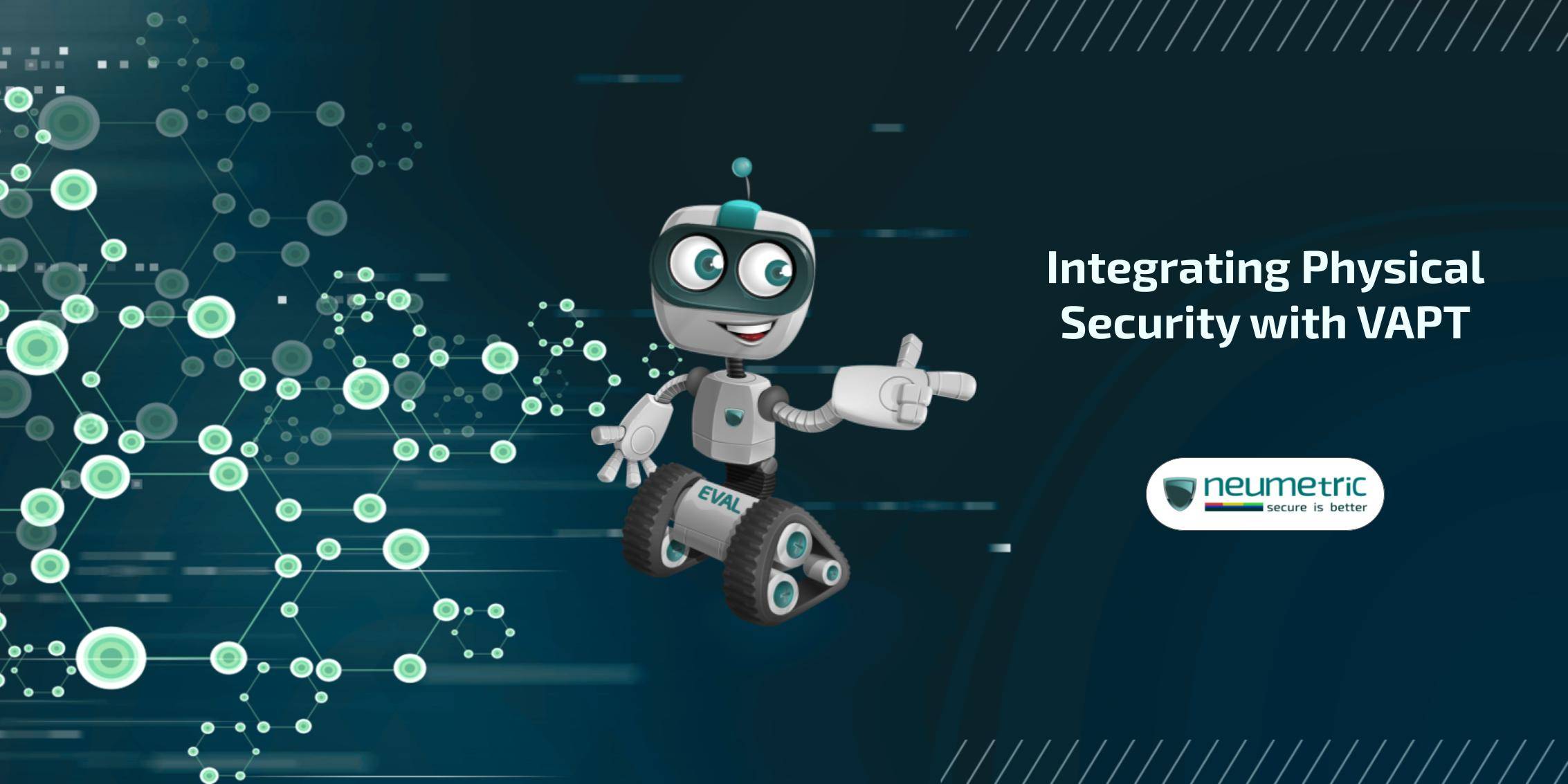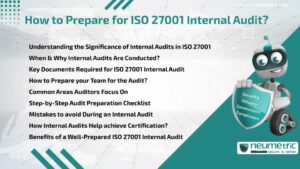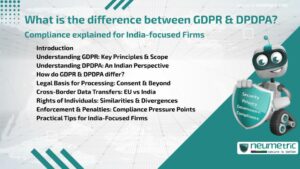Table of Contents
ToggleIntegrating Physical Security with VAPT
Introduction
Security is not just a buzzword; it’s a cornerstone for the smooth operation & survival of any modern entity. Beyond the digital realm, physical assets, personnel & sensitive information also demand protection. The rise in cybercrime, ranging from data breaches to ransomware attacks, underscores the urgency of shoring up defences on all fronts. Whether it’s safeguarding customer data, Intellectual Property [IP] or ensuring the physical safety of employees, the stakes are high. The financial repercussions of a security breach, coupled with the damage to reputation, can be insurmountable. It’s not just about preventing unauthorised access; it’s about fortifying the entire ecosystem against evolving threats.
Traditionally, physical security & cybersecurity have operated in silos. Physical security teams focused on access control, surveillance & on-the-ground measures, while cybersecurity experts addressed digital threats. However, the convergence of physical & cyber threats in recent years has rendered this division obsolete. An integrated approach is imperative. Consider a scenario where a cyber breach leads to a compromise in physical security systems, allowing unauthorised access to a secure facility. Conversely, a physical breach can open the door to cyber threats by providing a gateway for malicious actors to exploit digital vulnerabilities.
The interconnectedness of these realms necessitates a cohesive strategy—one that bridges the gap between the physical & the digital. This integration not only fortifies an organisation against multifaceted threats but also enhances the overall resilience of its security posture. By breaking down the traditional barriers between physical & cyber security, organisations can create a unified front that anticipates & mitigates risks comprehensively. This integrated approach is not merely a trend but a strategic necessity in the face of an ever-evolving threat landscape.
Understanding physical security
At its core, physical security is the shield that protects the tangible assets of an organisation. It’s the real-world barricade against unauthorised access, theft & other physical threats. Think of it as the first line of defence, the tangible counterpart to the digital fortress.
The components of physical security are like the gears in a well-oiled machine, each playing a distinct role in fortifying the perimeter. Access control systems, the first bastion, determine who gets in & who stays out. Whether it’s through key cards, biometrics or PINs, these systems regulate entry points. Surveillance cameras, the vigilant eyes, keep a watchful gaze on the surroundings. From Closed-Circuit Television [CCTV] to advanced video analytics, these cameras aren’t just a deterrent; they’re the silent witnesses capturing every move.
Perimeter security marks the outer limits of protection. Fences, gates & barriers create a physical boundary, dissuading potential intruders & giving security personnel a clear line of defence. Security guards, the human touch, are the boots on the ground. Trained to respond to various scenarios, they add a dynamic layer to physical security. Their presence isn’t just about deterring mischief; it’s about having a responsive force ready to react when the unexpected occurs.
Now, let’s dive into the measures organisations can take to secure their premises. These are not just security measures; they’re the tangible expressions of an organisation’s commitment to safety.
- Access control systems:
- Key cards, biometrics, PIN codes
- Electronic door locks & barriers
- Surveillance cameras:
- CCTV systems
- Advanced video analytics
- Perimeter security:
- Fences & gates
- Barriers & bollards
- Security personnel:
- Trained guards for on-site presence
- Mobile patrols for comprehensive coverage
- Intrusion detection systems:
- Sensors & alarms for unauthorised entry
- Integration with central monitoring stations
- Visitor management systems:
- Protocols for registering & tracking visitors
- Temporary access badges for controlled visits
Each measure serves as a layer, working in tandem to create a comprehensive shield. However, even the most robust physical security can be compromised without a parallel focus on digital threats. That’s where the integration of physical security with Vulnerability Assessment & Penetration Testing [VAPT] becomes not just a choice but a necessity.
Vulnerability Assessment & Penetration Testing [VAPT] Explained
VAPT is like the Sherlock Holmes of cybersecurity. It’s the detective work that goes beyond the surface to uncover hidden vulnerabilities & weak spots in your digital fortifications. In simpler terms, it’s a systematic way of figuring out where your defences might be weak.
Vulnerability Assessment [VA]: Think of VA as the inspector. It scans your systems, networks & applications, looking for potential weaknesses. It’s like your security systems’ annual check-up, catching issues before they turn into full-blown problems.
Penetration testing [PT]: Now, PT is the undercover agent. Once the vulnerabilities are spotted, penetration testers take on the role of the bad guys. They try to exploit those weaknesses, not to cause harm, but to show you where your defences need a bit more muscle.
Objectives of VAPT
- Identifying weaknesses: VAPT uncovers the chinks in your digital armor, be it in software, networks or even human practices.
- Risk assessment: It’s not just about finding vulnerabilities; it’s about understanding which ones pose the most risk. VAPT prioritises the critical issues that need urgent attention.
- Proactive defence: Rather than waiting for an attack, VAPT allows you to shore up your defences before the bad actors get a chance to knock on your virtual door.
In the ever-evolving landscape of cyber threats, VAPT is not a luxury; it’s a necessity. Here’s why:
- Staying ahead of evolving threats: Cyber threats don’t stand still & neither should your defences. VAPT keeps you one step ahead by anticipating how the bad guys might try to sneak in.
- Compliance & standards: In a world where data protection regulations are tightening, VAPT isn’t just a good idea; it’s often a legal requirement.
- Building trust: Whether you’re a business or an organisation, your stakeholders trust you with their data. Regular VAPT is a way of saying, “We take your security seriously.”
VAPT is not just about finding problems; it’s about staying proactive, building trust & making sure your digital fortress can stand up to whatever the wild world of the internet throws at it.
Benefits of integrating physical security with VAPT
Picture this: Your security cameras catch something fishy on the perimeter, but your VAPT team, armed with their cyber-sleuthing skills, detects a suspicious pattern in your network traffic. Together, they paint a fuller picture of the threat. Integration doesn’t just add more eyes; it adds smarter eyes that can connect the dots between the digital & the physical realms.
- Real-time collaboration: Physical security alerts trigger cyber investigations & vice versa. It’s like having a dynamic duo – Batman & Robin, but for security.
- Comprehensive threat analysis: By combining insights from both physical & digital realms, you get a 360-degree view of potential threats. It’s not just about reacting; it’s about being a step ahead.
When trouble brews, how fast can you react? That’s the name of the game. Integrating physical & cyber security creates a seamless response mechanism.
- Faster incident identification: If there’s a breach, you don’t want to waste time figuring out whether it’s a cyber-attack or a physical break-in. Integration streamlines this process for quicker identification.
- Coordinated action: Picture this: a breach triggers alarms in both the digital & physical security domains. The response team swings into action, addressing the threat holistically. It’s like having a well-choreographed dance of defence.
Cost-effectiveness of a unified security approach
- Streamlined operations: One team, one set of tools & one strategy for both physical & digital threats. It’s efficient, it’s streamlined & it’s cost-effective.
- Reduced false alarms: When security systems work together, false alarms go down. Why? Because the integration filters out noise, ensuring that when an alarm sounds, it’s the real deal.
Integrating physical security with VAPT is like turning security setup into a dynamic, tag-team duo. It’s not just about adding more layers; it’s about creating a synergy that makes defences more resilient, responsive & cost-effective.
Future trends in integrated security
Artificial Intelligence [AI] dominance: Imagine an AI system that not only detects unusual activities in your physical space but also predicts potential cyber threats based on patterns. We’re talking about AI algorithms working hand-in-hand with physical & cyber sensors, creating a proactive defence that’s more Sherlock Holmes than reactive security guard.
Internet of Things [IoT] integration: Your coffee machine is talking to your laptop & your thermostat is chatting with your security cameras. IoT is no longer just about convenience; it’s about creating a network that collaborates in real-time to fortify security.
Blockchain for secure authentication: Blockchain isn’t just for cryptocurrencies. It’s the key to creating unbreakable digital locks. Imagine a world where access to physical spaces & digital assets is secured through a decentralised, tamper-proof system.
Evolving threat landscape & adaptive security measures
Rise of cyber-physical attacks: Brace yourself for more attacks where the digital & physical worlds collide. Integrated security will need to evolve to counter threats that exploit vulnerabilities in both realms simultaneously.
Biometric advancements: Forget fingerprint scans; we’re talking about next-gen biometrics. From facial recognition to voice analysis, our future defences will be more personalised & harder to fool.
The role of Artificial Intelligence in Integrated Security
Predictive analysis & threat intelligence: AI isn’t just about automating tasks; it’s about predicting threats before they happen. Integrated security systems will use AI to analyse data from both physical & digital sources, providing actionable insights to stay ahead of the game.
Autonomous security measures: Picture security systems that don’t just alert you to a threat but autonomously respond to neutralise it. AI-driven robotics & drones could become the superheroes patrolling the physical grounds.
Environmental & health considerations
Health security integration: The future isn’t just about digital & physical threats; it’s also about health. Integrated security might involve monitoring health data to ensure a safe environment, especially in times of pandemics or health crises.
Environmental sensors for sustainability: Beyond security, integrated systems may include environmental sensors, contributing to sustainability efforts. Picture security measures that also help you reduce your carbon footprint.
Conclusion
Security isn’t a one-size-fits-all solution. It’s a constant evolution, a journey that requires staying on our toes. The future we glimpsed into—where AI predicts threats, where IoT integrates seamlessly & where security is a holistic part of our everyday lives—demands continuous improvement & adaptation.
As we wrap up this exploration into the fusion of physical & digital security, remember this: your security is only as strong as its weakest link. So, keep evolving, keep integrating & most importantly, stay ahead of the game. The landscape might change, but one thing is for sure: with the right strategies, the fortress will stand tall against the storm of threats. Here’s to a future where security isn’t just a measure; it’s a way of life.
FAQ
Why is it important to integrate physical security with VAPT?
Integrating physical security with VAPT is like having a superhero team for your defence. It’s not just about having guards & cameras; it’s about actively hunting down vulnerabilities in both the physical & digital realms. This integration adds a layer of intelligence, allowing for faster threat detection, a coordinated response & ultimately, a more resilient defence against the evolving landscape of security threats.
How does VAPT enhance overall security measures?
Think of VAPT as the Sherlock Holmes of cybersecurity. It goes beyond the surface, scanning for potential weaknesses in your digital fortress. The combination of Vulnerability Assessment [VA] & Penetration Testing [PT] is like having a security check-up & an undercover agent, all in one. VAPT not only identifies vulnerabilities but also prioritises them, allowing for a proactive defence strategy. It’s not just about reacting to threats; it’s about staying ahead of them.
What are the future trends in integrated security & how will they impact businesses?
The future of integrated security is a fascinating frontier. From the dominance of Artificial Intelligence [AI] & Internet of Things [IoT] integration to the rise of cyber-physical attacks, businesses can expect a shift towards more proactive, adaptive & personalised security measures. Emerging technologies like blockchain & advancements in biometrics will play a crucial role. Businesses that embrace these trends will not only enhance their security but also stay ahead in the game of evolving threats.





